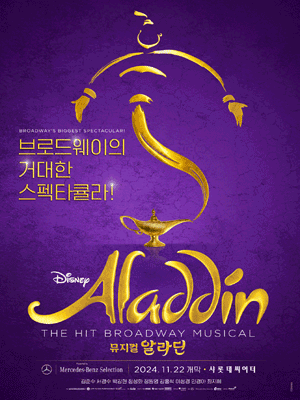Aladdin

I attended the Korean production of "Aladdin" for two reasons: first, to write a comparison review, and second, to give my younger son a chance to watch the show. I had already seen the Broadway version with my older son, who has a mechanical mind, whereas my younger son has good musical ears.
The cast I saw included Kyungsu Seo as Aladdin, Kang Hong Seok as Genie, and Kyoungah Min as Jasmine.
The initial set design looked similar to Broadway. The stealing sequence felt natural, with Aladdin singing comfortably when the songs stayed melodic. I realized that "One Jump Ahead" and "Proud of Your Boy" feature many mid-range notes with small variations. Aladdin followed the melody, but his pitch was sometimes unstable. This is a common challenge for tenors, especially when melodies sit in the midrange where speaking and singing overlap. Interestingly, I had heard this actor perform different songs online with good results, suggesting that the demands of live musical theater, especially in this range, posed particular challenges in this performance. While occasional vocal difficulties are understandable, they did affect the overall impact of his songs.
When Jasmine sang "These Palace Walls," I was relieved to hear a well-sung and stable performance.
The phrase "Diamond in the Rough" was translated as "흙 속의 다이아몬드" (diamond buried in clay or soil). While this conveys a similar meaning, it suggests a diamond that only needs brushing off to become valuable. In contrast, the original phrase refers to an uncut diamond that requires grinding and polishing — a deeper metaphor for Aladdin’s potential. "다이아몬드 원석" (uncut diamond) might have captured that nuance more closely and would also have worked well rhythmically in the lyrics. Since this phrase recurs as an important theme throughout the show, I thought a more precise translation could have preserved the original meaning better. Additionally, the fricative ending of "rough" in English and the plosive ending of "석" in Korean provide a surprisingly good match in spoken delivery, maintaining both the metaphorical meaning and the theatrical impact.
Aladdin’s three friends were strong actors and singers.
The entrance to the cave was displayed on a curtain — understandable, considering the relatively short (seven months) run. When the curtain opened, the cave entrance appeared at the back of the stage, with multiple treasure towers placed in front. On Broadway, the outside entrance — black with beaming eyes — transformed into the inside seamlessly with a brief blackout, changing to a grey-toned interior through simple lighting adjustments. Without movable rails to bring the treasure towers in, it may have been difficult in this production to shift the sets quickly enough, making the curtain necessary. Still, I wondered if clever light dimming could have preserved the original stage flow.
Another disappointment was seeing Genie enter from backstage rather than jumping up from underneath, as in the Broadway version. Apparently, there were no elevating mechanisms in this production. Actors often appeared or disappeared behind curtained boxes or large props, which felt a little clumsy.
When Genie spoke and sang, I noticed his vocal condition was not good at first. It improved as the show went on, but during ensemble numbers, his voice still did not come through clearly. However, Kang Hong Seok’s acting skills carried the performance. His almost one-man show lasting about 20 minutes had the audience laughing, even though he shared the stage with the chorus and dancers during this time.
Like the Broadway version, Genie demonstrated examples of wishes behind three doors. One was a Signiel Apartment (priced around 10 to 20 million US dollars), which earned the biggest applause from the audience.
Jafar and Iago formed a good comic pair, much like on Broadway. The translation for their scenes was quite good.
By the end of Act I, my son commented, "The songs made me uncomfortable before Jasmine sang." I had to agree. Act I heavily features Aladdin’s songs in the beginning and Genie’s later, with only small parts for other characters, including Jasmine. With unstable vocals from the main leads, the act lost much of its emotional impact.
Act II began with the arrival of Prince Ali of Ababwa, and Genie’s voice sounded much better by then. The magic carpet ride looked similar to Broadway’s staging. Jasmine’s voice had beautiful resonance, perfectly suited for the role — I only wished she had more songs to showcase her talents.
Throughout the second act, I kept missing the elevating mechanisms when I saw actors disappear behind large props. For Jafar’s disappearance, a box was placed behind him instead of a dramatic descent. Nevertheless, the dances and choral work were strong, and Aladdin’s friends continued to impress with convincing acting and good singing voices.
I understand that elaborate stage mechanics can be costly, especially for a shorter run. Broadway likely benefits from standardized touring routines. However, I noticed some vocal instability among the main actors, which affected the overall impact of the performance. While occasional off-days are inevitable in live theater, I believe the music director and producer could take a more active role in supporting the performers and addressing recurring challenges. The multicasting system without flexible understudies also makes it difficult to adjust casting at short notice. Regularly reviewing performance recordings could help identify and resolve issues early.
Broadway is not perfect — no human effort is — and sometimes Korean productions can even surpass Broadway by focusing on the simple principles of good singing, good acting, and good production.